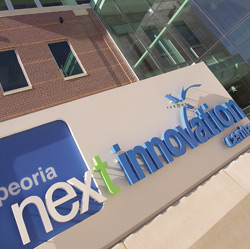Five Steps to Technology Commercialization

“Technology commercialization is the process of converting ideas into businesses and consequentially, jobs,” says Shad Sleeth, assistant director of Bradley University’s Technology Commercialization Center (BTCC). “It plays a critical role in economic development, as it effectively transfers ideas from the mind or the laboratory to the marketplace. Primary sources of new technology are universities, laboratories or Research and Development divisions within private-sector companies in which knowledge is the primary outcome. However, to have social and economic impact, additional value must be created. Commercialization is the process through which such value is infused into an innovation by coupling the innovation with the business development necessary to build a revenue- and job-producing entity.”
Central Illinois is fortunate to have several economic drivers that work in a collaborative effort to move the economy forward. This effort is particularly evident in the world of technology commercialization. Peoria NEXT’s mission encapsulates this concept: Through collaboration and creativity, Peoria NEXT will facilitate Discovery, Innovation and Commercialization. A family member of the Heartland Partnership, Peoria NEXT has partnered with the BTCC to operate, manage and provide business services to start-up companies within the Peoria NEXT Innovation Center. Additionally, Peoria NEXT works with the Economic Development Council for Central Illinois and the Heartland Capital Network to provide business retention and capital assessments.
The Discovery and Innovation process can be iterative, bouncing in a multitude of directions through trial, error, learning and back, until finally—success. However, the process for commercializing that discovery can be simplified to a five-step illustration of a complex process.
Opportunity
The Opportunity phase consists of identifying the scientific and commercial value of the discovery. For many inventors and scientists, the scientific value may be more straightforward than revealing the commercial value. The commercial value is simply that there is a market and customers who are willing to pay for your technology—that it meets a need, either real or perceived. Key steps in this process include cultivating a professional network in your field of expertise, research and documentation. Proper documentation is critical in this phase, as it will become an integral part of the protection of your innovation. Keep detailed records and do not make public disclosures concerning your idea. Sharing your idea without proper “non-disclosures” may jeopardize the future protection of your concept.
There are several resources available to assist you in the initial evaluation process. The BTCC works closely with researchers, inventors and entrepreneurs to transform their technologies into commercial enterprises. For non-technology-related innovations, Bradley’s Turner Center for Entrepreneurship or the Peoria SCORE Chapter can assist in new-venture evaluations and guidance.
Protection
Once a meticulous description of the discovery is complete, a patent, trademark or copyright protection process can be initiated. A patent gives you the exclusive right to prevent others from making and selling your invention. Trademarks offer protection for brands, symbols, logos and colors. Copyrights protect original works of authors, composers, programmers and screenwriters. In some cases, acquiring a patent may take longer than the window of opportunity for commercialization will allow.
As the innovation is taking shape, evaluate your business development goals. Do a little “daydreaming” about the future of your discovery. Is this an intellectual property to be developed and sold to enhance the business of an existing company, or is this a technology that will launch a unique start-up company?
Business Case and Commercialization Plan
This part of the process will determine if the innovation or discovery is truly feasible. “Will the dogs eat it?” is a phrase that could describe the development or creation of the business case. It involves a comprehensive analysis of the industry and market, creating the value proposition, and close identification of the customer. It is imperative to hone in on the customers’ needs and expectations in this phase, as it will impact everything from product features to the distribution plan. You will also need to document the business operations, policies, legal structure of the business, marketing and growth plans, financials, and the team needed to make your venture a success. The Peoria NEXT program, NEXT Steps, is designed to provide detailed feedback on commercialization plans and informal networking between innovators and investors.
Building the Team and Securing Capital
Having the right expertise on your team will not only make the project more viable, it is critical to securing the needed capital investment for implementation and commercialization. Investors need to be assured that you have the necessary expertise to execute your plan. In this phase, “you have typically exhausted your friends, family and fools network and need additional funding to move forward,” according to Kip McCoy of the Heartland Capital Network. “You will need to prove to investors that you can make progress on your commercialization plan in a specified amount of time.” Ownership issues and partnership opportunities need to also be considered and outlined for the investors. Peoria NEXT, in conjunction with the Heartland Capital Network, can connect any business to angel investors, venture capital funds and other state and federal grant opportunities.
Executing the Plan and Developing the Product
Your work to this point has been preparation for starting the business or executing your commercialization plan. This phase includes the deal-making negotiations of selling the technology to an existing business or the start-up process of a new business venture. Roughly, the start-up process includes finding a physical location to operate your business, hiring personnel, physically organizing your business workflow, stocking supplies, developing prototypes and general administrative organization.
At every step along the way, your business development plan will need to be reviewed, modified and refined. Peoria NEXT has seasoned mentors to help you with each step in commercializing your technology. Vickie Clark, COO of the Economic Development Council for Central Illinois, states, “Cultivating an entrepreneurial environment and increasing the commercialization of new technologies is a growth industry for our region. As these new businesses grow, they collectively create significant jobs. The 13 companies currently part of the Peoria NEXT Innovation Center employ approximately 67 people.” iBi

